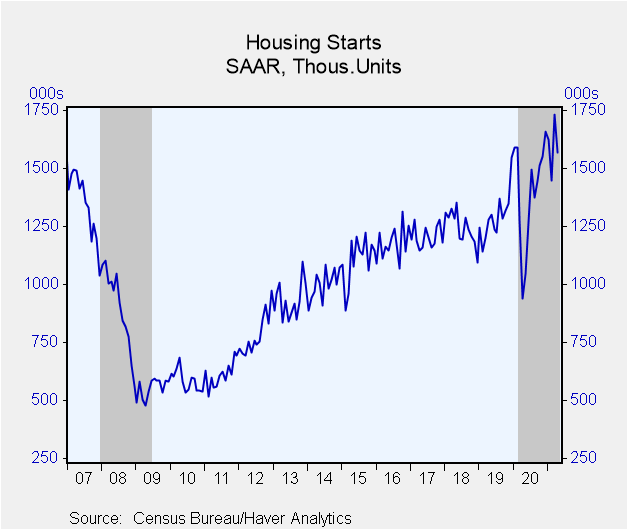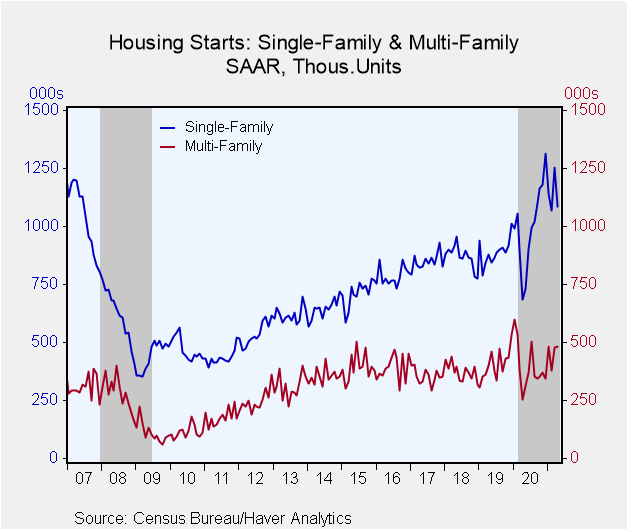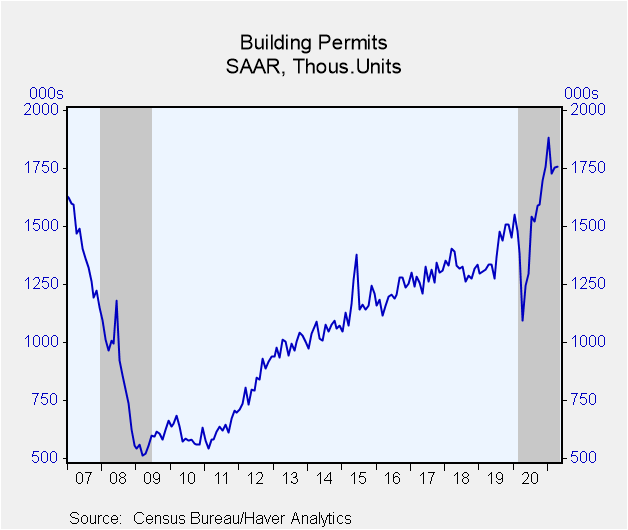 Global| May 18 2021
Global| May 18 2021U.S. Housing Starts Unexpectedly Fall Sharply in April
by:Tom Moeller
|in:Economy in Brief
Summary
• Single-family starts decline while multi-family starts improve. • Building permits edge higher. Housing starts declined 9.5% (+67.3% y/y) during April 1.569 million units (SAAR) from 1.733 million in March, revised from 1.739 [...]
• Single-family starts decline while multi-family starts improve.
• Building permits edge higher.
Housing starts declined 9.5% (+67.3% y/y) during April 1.569 million units (SAAR) from 1.733 million in March, revised from 1.739 million. The Action Economics Forecast Survey expected April starts of 1.718 million. February starts were revised to 1.447 million from 1.457 million. Earlier figures also were revised.
Starts of single-family homes fell 13.4% (+58.7% y/y) in April to 1.087 million from 1.255 million in March, revised from 1.238 million. Single-family starts during February were revised as well to 1.069 million from 1.074 million. Starts of multi-family units improved 0.8% last month (+90.5% y/y) to 482,000 from 478,000 in March, revised from 501,000. Multi-family starts were revised to 378,000 in February from 383,000.
Building permits rose 0.3% (60.9% y/y) last month to 1.760 million from 1.755 million in March, revised from 1.766 million. Permits fell to 1.726 million in February, revised from 1.720 million. Permits to build single-family homes declined 3.8% (+70.7% y/y) to 1.149 million and reversed most of the March increase. Permits to build multi-family homes improved 8.9% (45.1% y/y) to 611,000 after falling for two straight months.
By region, housing starts in the Northeast rose 6.2% (244.0% y/y) to 172,000 after rising 48.6% in March. In the Midwest, starts weakened 34.8% (+40.9% y/y) to 193,000 after more-than-doubling in March. Housing starts in the South fell 11.5% (+41.3% y/y) to 804,000 following a 17.8% rise in March. In the West, starts improved 9.0% (119.8% y/y) to 400,000 after falling 14.8% during March.
The housing starts and permits figures can be found in Haver's USECON database. The expectations figure is contained in the AS1REPNA database.
| Housing Starts (000s, SAAR) | Apr | Mar | Feb | Apr Y/Y % | 2020 | 2019 | 2018 |
|---|---|---|---|---|---|---|---|
| Total | 1,569 | 1,733 | 1,447 | 67.3 | 1,397 | 1,292 | 1,247 |
| Single-Family | 1,087 | 1,255 | 1,069 | 58.7 | 1,004 | 889 | 871 |
| Multi-Family | 482 | 478 | 378 | 90.5 | 393 | 403 | 376 |
| Starts By Region | |||||||
| Northeast | 172 | 162 | 109 | 244.0 | 113 | 115 | 111 |
| Midwest | 193 | 296 | 136 | 40.9 | 193 | 169 | 170 |
| South | 804 | 908 | 771 | 41.3 | 743 | 687 | 630 |
| West | 400 | 367 | 431 | 119.8 | 347 | 321 | 336 |
| Building Permits | 1,760 | 1,755 | 1,726 | 60.9 | 1,479 | 1,385 | 1,329 |
Tom Moeller
AuthorMore in Author Profile »Prior to joining Haver Analytics in 2000, Mr. Moeller worked as the Economist at Chancellor Capital Management from 1985 to 1999. There, he developed comprehensive economic forecasts and interpreted economic data for equity and fixed income portfolio managers. Also at Chancellor, Mr. Moeller worked as an equity analyst and was responsible for researching and rating companies in the economically sensitive automobile and housing industries for investment in Chancellor’s equity portfolio. Prior to joining Chancellor, Mr. Moeller was an Economist at Citibank from 1979 to 1984. He also analyzed pricing behavior in the metals industry for the Council on Wage and Price Stability in Washington, D.C. In 1999, Mr. Moeller received the award for most accurate forecast from the Forecasters' Club of New York. From 1990 to 1992 he was President of the New York Association for Business Economists. Mr. Moeller earned an M.B.A. in Finance from Fordham University, where he graduated in 1987. He holds a Bachelor of Arts in Economics from George Washington University.










